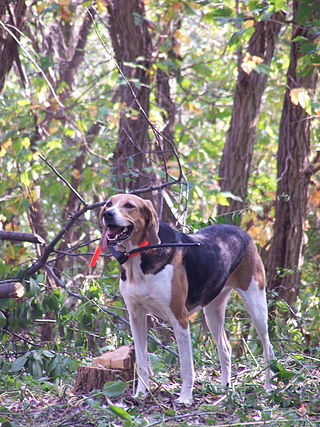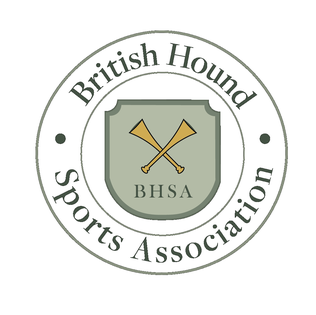Related Research Articles

The Harrier is a medium-sized dog breed of the hound class, used for hunting hares by trailing them. It resembles an English Foxhound but is slightly smaller, though not as small as a Beagle. The breed has been used since the mid 13th century.

A hound is a type of hunting dog used by hunters to track or chase prey.

Fox hunting is a traditional activity involving the tracking, chase and, if caught, the killing of a fox, normally a red fox, by trained foxhounds or other scent hounds. A group of unarmed followers, led by a "master of foxhounds", follow the hounds on foot or on horseback.

Scent hounds are a type of hound that primarily hunts by scent rather than sight. These breeds are hunting dogs and are generally regarded as having some of the most sensitive noses among dogs. Scent hounds specialize in following scent or smells. Most of them tend to have long, drooping ears and large nasal cavities to enhance smell sensitivity. They need to have relatively high endurance to be able to keep track of scent over long distances and rough terrain. It is believed that they were first bred by the Celts by crossbreeding mastiff-type dogs with sighthounds. The first established scent hounds were St. Hubert Hounds bred by monks in Belgium during the Middle Ages.

A foxhound is a type of large hunting hound bred for strong hunting instincts, a keen sense of smell, and their bark, energy, drive, and speed. In fox hunting, the foxhound's namesake, packs of foxhounds track quarry, followed—usually on horseback—by the hunters, sometimes for several miles at a stretch; moreover, foxhounds also sometimes guard sheep and houses.

Beagling is mainly the hunting of hares and rabbits by beagles using their strong sense of smell. A beagle pack is usually followed on foot, but in a few cases mounted. Beagling is often enjoyed by 'retired' fox hunters who have either sustained too many injuries or lost the agility to ride horseback, or who enjoy the outdoors and the camaraderie of the hunt. It is also traditionally a way for young men and women to learn how to handle hounds on a smaller scale before they go on to hunt with foxhounds.

The Hunt Saboteurs Association (HSA) is a United Kingdom organisation that uses hunt sabotage as a means of direct action to stop fox hunting. It was founded in 1963, with its first sabotage event occurring at the South Devon Foxhounds on 26 December 1963.

Drag hunting or draghunting is a form of equestrian sport, where mounted riders hunt the trail of an artificially laid scent with hounds.

The Otterhound is an English dog breed. It is a scent hound and is currently recognised by the Kennel Club as a Vulnerable Native Breed with around 600 animals worldwide.

The American Foxhound is a breed of dog, closely related to the English Foxhound. They are scent hounds, bred to hunt foxes by scent. United States Founding Father George Washington was key to the breed's early development.
Hunt sabotage is the direct action that animal rights activists and animal liberation activists undertake to interfere with hunting activity.

The Southern Hound was a breed of dog that existed in Britain probably until sometime in the 19th century, now extinct. The exact date of its extinction is not known; it is likely that it was gradually interbred with other breeds until the genuine Southern Hound bloodline ceased to exist.

Hound trailing, or hound racing, is a dog sport that uses specially bred hounds to race along an artificially laid scent trail over a cross country course.
The Crawley and Horsham Hunt is a United Kingdom foxhound pack, with hunting country of around 23 miles by 20 miles within the ceremonial county of Sussex.

Trail hunting is a legal, although controversial, alternative to hunting animals with hounds in Great Britain. A trail of animal urine is laid in advance of the 'hunt', and then tracked by the hound pack and a group of followers; on foot, horseback, or both.

The Warwickshire Hunt is an English fox hunting pack founded in 1791.

The Staghound, sometimes referred to as the English Staghound, is an extinct breed of scent hound from England. A pack hound, the breed was used to hunt red deer and became extinct in the 19th century when the last pack was sold.

The West Country Harrier, sometimes called Somerset Harrier, is a breed of scent hound from the south west of England that is used to hunt hare in packs. The West Country Harrier is often considered to be a variety of the more common Harrier breed, which is sometimes referred to as the Studbook Harrier.

The British Hound Sports Association (BHSA) is the governing body for many hound sports associations in Great Britain. However, it is not the governing body for either draghound packs or bloodhound packs who are governed by the Master of Draghound & Bloodhounds Association (MDBA). The BHSA is responsible for setting standards and rules to which members and registered hunts are supposed to adhere. A sister organisation, the Hound Sports Regulatory Authority (HSRA), is responsible for regulatory and disciplinary matters for members and member hunts, in accordance with rules set by the BHSA.
References
- 1 2 "Mink hunting on the rise" BBC, 15 June 2003
- ↑ Management of American mink and interactions with native mustelids Archived 2011-12-09 at the Wayback Machine , Wildlife Conservation Research Unit. Accessed 6 June 2013.
- ↑ Mink Bounty Notice Archived 2013-07-08 at the Wayback Machine , National Association of Regional Game Councils (Ireland). Accessed 6 June 2013
- ↑ "Irish Mink Hounds Association" Archived 2014-08-10 at the Wayback Machine Hunting Association of Ireland
- ↑ "Hunting". Ethics. BBC. Retrieved 6 June 2013.